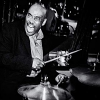Home » Jazz Articles » Live Review » Shelley Hirsch: Back with a Vengeance
Shelley Hirsch: Back with a Vengeance
Hirsch—vocal acrobat, poet, performance artist—was a new music original long before downtown moved across the river to Brooklyn.
The vocal acrobat, poet and performance artist was a new music original long before "downtown" moved across the East River. An original member of the avant rock band The Public Servants, Hirsch also worked her way through fringe arts circles in San Francisco and then Europe before returning to her native ground in New York City. Arriving in time for the underground creative milieu's coming of age, she began collaborating with turntable artist Christian Marclay, genre-defying composers and multi-instrumentalists John Zorn and Elliot Sharp and assorted new wave artists. "I wanted to use my voice the way Arto Lindsay [of DNA and the Golden Palominos] did—utterly raw—but I couldn't quite go that route," Hirsch explained to this writer several years ago. After crafting her own extended vocal concepts, she spent decades working within both new dramaturgy and free jazz on the edge.
At this point, Hirsch's resume reads like a list of some of the most vital avant gardists including Lawrence "Butch" Morris, Jin Hi Kim, Ned Rothenberg, Alvin Curran, Fred Frith and Ikue Mori as well as the aforementioned Marclay, Zorn and Sharp. She's played every major experimental arts festival with multiple tours around the planet. Then, there was this thing called the pandemic and a damning silence.
On March 15, Hirsch was back onstage for the first time in too long. Roulette, which had hosted many of her past performances, broadcast it widely. The house was necessarily empty, darkness ensued, but the downtown magic persisted. "The Body Remembers," a work comprising older and new pieces, seemed to confront her issues with this lockdown—both aesthetic and sociological. But Hirsch has long conceived of art grown from the body's own memory. "It's our biggest recorder and our storage house," she has assured.
The performance began full throttle with her "Paper Piece" of 1986, revealing the singer seated amid shredded wrappings, cartons, and newsprint in the glimmer of a tight spotlight. Hirsch's theatrical, aerial vocals painted the hollow theater with vocalizations including her trademark affective shifts. Childlike, Hirsch upturned the torn sheets, hinting at words but speaking in splinters while expanding the circular construction of paper as the stage lights slowly widened.
"Letting the Electronics Lead Me" had Hirsch seated at a black-draped table that included a series of electronics feeding her voice through effects and delays. In a blunted sort of Sprechgesang, she pondered, "I was...I was lost...I was found" with an electronic harmonizer enhancing natural leaps over octaves.
She was next joined by sound artist Michael Schumacher, who wielded his own array of computer-controlled electronics, casting sounds around Hirsch's operatic utterances and readings. As she's been wont to do in recent years, Hirsch was writing real-time prose and poetry on large, variously positioned pads and sheets, allowing the sounds as well as her own frenetic movements to inspire the words. Schumacher's contrapuntal music, based in his own compositions, rang out in variously-metered repetition. Throughout the performance, Roulette's masterful videographers not only recorded the event but actually became another aspect of the performance, fading and overlapping the imagery, moods and messages as Hirsch bent, swooned and emoted.
The final piece was a duet with rising star violist Joanna Mattrey who played rich, dark accompaniment to Hirsch's spoken prose. Again, the vocalist wrote in real time, now at a laptop with the words projected on a large screen overhead. The work, a meditation on the anniversary of New York's 2020 lockdown, was riveting. As Mattrey's haunting modal improvisation—so spare in its vibrato—resounded across the hall, Hirsch assured viewers as much as herself that "We will touch again." New York is surely working its way there, day in and out.
Tags
Live From New York
Shelley Hirsch
John Pietaro
United States
New York
New York City
Christian Marclay
john zorn
Elliot Sharp
Butch Morris
Jin Hi Kim
Ned Rothenberg
Alvin Curran
Fred Frith
Ikue Mori
Michael Schumacher
Joanna Mattrey
PREVIOUS / NEXT
Support All About Jazz
 All About Jazz has been a pillar of jazz since 1995, championing it as an art form and, more importantly, supporting the musicians who make it. Our enduring commitment has made "AAJ" one of the most culturally important websites of its kind, read by hundreds of thousands of fans, musicians and industry figures every month.
All About Jazz has been a pillar of jazz since 1995, championing it as an art form and, more importantly, supporting the musicians who make it. Our enduring commitment has made "AAJ" one of the most culturally important websites of its kind, read by hundreds of thousands of fans, musicians and industry figures every month.



























